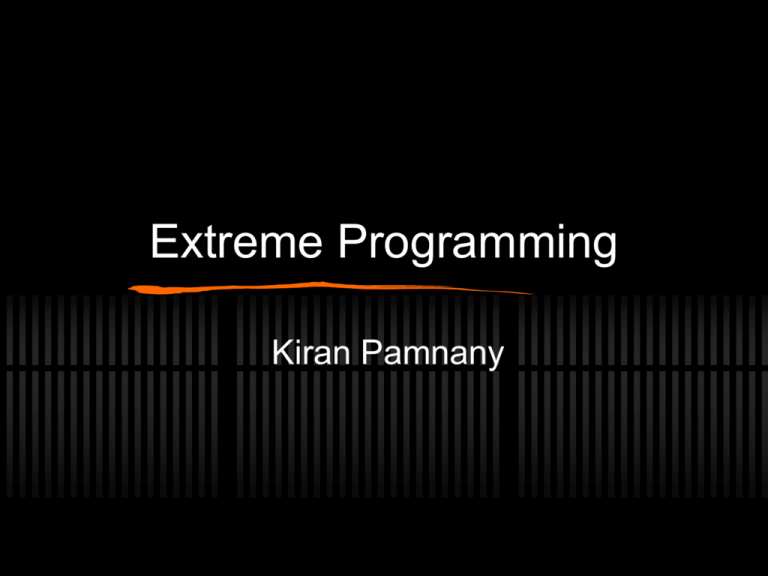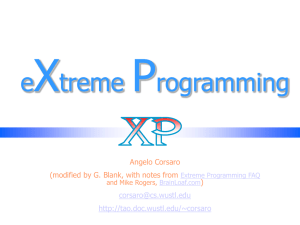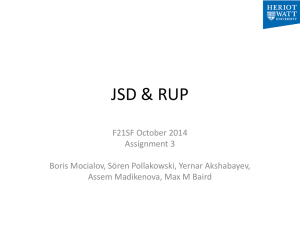Extreme Programming - Brown University Department of Computer
advertisement

Extreme Programming Kiran Pamnany Software Engineering Computer programming as an engineering profession rather than an art or a craft Meet expectations: Functionality Reliability Cost Delivery schedule Methodologies Methodology: codified set of recommended practices No consensus: Waterfall model Spiral model Rational Unified Process (RUP) Extreme Programming (XP) Classic process steps Requirements Analysis Specification Design and Architecture Coding Testing Documentation Maintenance Waterfall model Proposed in 1970 by W. W. Royce Development flows through steps: Requirements analysis Architectural design Detailed design Coding, debugging and unit testing Integration and system testing Deployment, operation and maintenance Waterfall model (cont.) Pros: Track progress easily due to clear stages Easily identifiable milestones and deliverables Cons: Inflexible: difficult to respond to changing requirements Design and coding discover requirements inconsistencies Some problems not discovered until system testing Spiral model Defined in 1986 by Barry Boehm Modified waterfall Software is developed in a series of incremental releases Early releases are prototypes Later releases become increasingly complete Receive feedback after each release Spiral model (cont.) Pros: Systematic and stepwise, but in an iterative framework Estimates get more realistic as work progresses Some ability to cope with changing requirements Cons: Time-intensive process Not extensively used Rational Unified Process (RUP) Defined in 1997 by Grady Booch, Ivar Jacobson and James Rumbaugh General framework to describe specific development processes Designed to be tailored for a given software project with consideration for its size and type Recognized to be particularly applicable to large projects with large teams RUP Phases Inception Shared understanding of the system with the customer Elaboration Architecture to build the system Construction Developing the system Transition Customer takes ownership of system RUP Guidelines Develop iteratively Deal with changing requirements Address high risk items as the highest priority tasks at each iteration Ideally, each iteration has an executable release Manage requirements Document functionality, constraints, design decisions, business requirements Define use cases and scenarios RUP Guidelines (cont.) Use component architecture For extensibility and reusability (CORBA/COM) Model software visually Abstraction using UML Verify software quality Plan quality control and assessment Involve all team members Control changes to software Use secure workspaces RUP Workflows - Typical Project (Source: George Stepanek, 2004) RUP Criticism ‘High ceremony methodology’ Bureaucratic: process for everything Slow: must follow process to comply Excessive overhead: rationale, justification, documentation, reporting, meetings, permission Extreme Programming (XP) Formulated in 1999 by Kent Beck, Ward Cunningham and Ron Jeffries Agile software development methodology (others: Scrum, DSDM) Developed in reaction to high ceremony methodologies XP: Why? Previously: Get all the requirements before starting design Freeze the requirements before starting development Resist changes: they will lengthen schedule Build a change control process to ensure that proposed changes are looked at carefully and no change is made without intense scrutiny Deliver a product that is obsolete on release XP: Embrace Change Recognize that: All requirements will not be known at the beginning Requirements will change Use tools to accommodate change as a natural process Do the simplest thing that could possibly work and refactor mercilessly Emphasize values and principles rather than process XP Practices (Source: http://www.xprogramming.com/xpmag/whatisxp.htm) XP Practices: Whole Team All contributors to an XP project are one team Must include a business representative--the ‘Customer’ Provides requirements Sets priorities Steers project Team members are programmers, testers, analysts, coach, manager Best XP teams have no specialists XP Practices: Planning Game Two key questions in software development: Predict what will be accomplished by the due date Determine what to do next Need is to steer the project Exact prediction (which is difficult) is not necessary XP Practices: Planning Game XP Release Planning Customer presents required features Programmers estimate difficulty Imprecise but revised regularly XP Iteration Planning Two week iterations Customer presents features required Programmers break features down into tasks Team members sign up for tasks Running software at end of each iteration XP Practices: Customer Tests The Customer defines one or more automated acceptance tests for a feature Team builds these tests to verify that a feature is implemented correctly Once the test runs, the team ensures that it keeps running correctly thereafter System always improves, never backslides XP Practices: Small Releases Team releases running, tested software every iteration Releases are small and functional The Customer can evaluate or in turn, release to end users, and provide feedback Important thing is that the software is visible and given to the Customer at the end of every iteration XP Practices: Simple Design Build software to a simple design Through programmer testing and design improvement, keep the software simple and the design suited to current functionality Not a one-time thing nor an up-front thing Design steps in release planning and iteration planning Teams design and revise design through refactoring, through the course of the project XP Practices: Pair Programming All production software is built by two programmers, sitting side by side, at the same machine All production code is therefore reviewed by at least one other programmer Research into pair programming shows that pairing produces better code in the same time as programmers working singly Pairing also communicates knowledge throughout the team XP Practices: Test-Driven Development Teams practice TDD by working in short cycles of adding a test, and then making it work Easy to produce code with 100 percent test coverage These programmer tests or unit tests are all collected together Each time a pair releases code to the repository, every test must run correctly XP Practices: Design Improvement Continuous design improvement process called ‘refactoring’: Removal of duplication Increase cohesion Reduce coupling Refactoring is supported by comprehensive testing--customer tests and programmer tests XP Practices: Continuous Integration Teams keep the system fully integrated at all times Daily, or multiple times a day builds Avoid ‘integration hell’ Avoid code freezes XP Practices: Collective Code Ownership Any pair of programmers can improve any code at any time No ‘secure workspaces’ All code gets the benefit of many people’s attention Avoid duplication Programmer tests catch mistakes Pair with expert when working on unfamiliar code XP Practices: Coding Standard Use common coding standard All code in the system must look as though written by an individual Code must look familiar, to support collective code ownership XP Practices: Metaphor XP Teams develop a common vision of the system With or without imagery, define common system of names Ensure everyone understands how the system works, where to look for functionality, or where to add functionality XP Practices: Sustainable Pace Team will produce high quality product when not overly exerted Avoid overtime, maintain 40 hour weeks ‘Death march’ projects are unproductive and do not produce quality software Work at a pace that can be sustained indefinitely XP Values Communication Simplicity Feedback Courage XP Values: Communication Poor communication in software teams is one of the root causes of failure of a project Stress on good communication between all stakeholders--customers, team members, project managers Customer representative always on site Paired programming XP Values: Simplicity ‘Do the Simplest Thing That Could Possibly Work’ Implement a new capability in the simplest possible way Refactor the system to be the simplest possible code with the current feature set ‘You Aren’t Going to Need It’ Never implement a feature you don’t need now XP Values: Feedback Always a running system that delivers information about itself in a reliable way The system and the code provides feedback on the state of development Catalyst for change and an indicator of progress XP Values: Courage Projects are people-centric Ingenuity of people and not any process that causes a project to succeed XP Criticism Unrealistic--programmer centric, not business focused Detailed specifications are not written Design after testing Constant refactoring Customer availability 12 practices are too interdependent XP Thoughts The best design is the code. Testing is good. Write tests before code. Code is complete when it passes tests. Simple code is better. Write only code that is needed. Reduce complexity and duplication. Keep code simple. Refactor. Keep iterations short. Constant feedback. Software Quality: Another View A programmer presenting an elegant but ‘inefficient’ solution, talks of the inelegant but ‘efficient’ solution […] but your solution doesn’t work: if the solution doesn’t have to work, then Begin..End is a valid solution. Gerald Weinberg, ‘The Psychology of Computer Programming’, 1972 Software Quality: Another View […] software engineering has accepted as its charter “How to program if you cannot.” E.W. Dijkstra, ‘The Cruelty of Really Teaching Computer Science’, 1988 Computer programming as a branch of mathematics--formal provability of a program is a major criterion for correctness Program correctness is ‘constitutional’; an incorrect program is worthless or of negative worth Formal Verification The act of proving or disproving a system’s correctness with respect to a formal specification or property, using formal methods System types include FSM, Petri nets, timed and hybrid automata, cryptographic protocols, combinatorial circuits, etc. Properties to be verified are described in temporal logics; approaches include state space enumeration, abstract interpretation, etc. Formal Methods Mathematical techniques for the specification, development and verification of software and hardware systems Classified as: Denotational semantics Operational semantics Axiomatic semantics The Way Forward? ‘High ceremony’ software engineering methodologies in disfavor Agile software development methodologies in increasing use, but with significant criticism Formal methods will never have a significant impact until they can be used by people that don’t understand them. T. Melham










